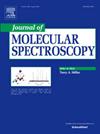Measurement of O2 and O3 absorption cross-sections in the 180–270 nm by controlling the conversion of O2 to O3 in the linear-absorption region
IF 1.3
4区 物理与天体物理
Q4 PHYSICS, ATOMIC, MOLECULAR & CHEMICAL
引用次数: 0
Abstract
Oxygen (O2) and ozone (O3) are of crucial importance to human health and environmental sustainability. Concentrations of O2 and O3 can be measured by UV absorption spectroscopy, in which the absorption cross-section (ACS) is a very critical physical parameter for calculating concentrations. However, the existing ACS of O2 and O3 are biased because the conversion of O2 to O3 and nonlinear effects in absorption are ignored in the measurement of ACS. In this study, the ACS for O2 and O3 are obtained by considering the conversion of O2 to O3 and the nonlinear effects. First, the conversion of O2 to O3 is inhibited by controlling gas flow rate and light intensity in the measurement of O2 and O3 ACS. Then the concentration of O3 is indirectly calculated by controlling conversion of O2 to O3 during the measurement of ACS of O3. Next, the linear-absorption regions for O2 and O3 are determined by constructing the relationship between absorption intensities and concentrations to eliminate the influence of nonlinear effect. The maximum ACS for oxygen and ozone are cm2/molecule ( = 180.51 nm) and cm2/molecule ( = 255.39 nm) by controlling conversion of O2 to O3 in the linear-absorption region, respectively.

通过在线性吸收区控制O2到O3的转化,测量了180 ~ 270 nm O2和O3的吸收截面
氧(O2)和臭氧(O3)对人类健康和环境可持续性至关重要。紫外吸收光谱法可以测量O2和O3的浓度,其中吸收截面(ACS)是计算浓度的一个非常关键的物理参数。然而,由于在ACS的测量中忽略了O2到O3的转化和吸收中的非线性效应,现有的O2和O3的ACS存在偏差。在本研究中,考虑了O2到O3的转化和非线性效应,得到了O2和O3的ACS。首先,在测量O2和O3 ACS时,通过控制气体流速和光强来抑制O2向O3的转化。然后在测量O3的ACS时,通过控制O2向O3的转化,间接计算出O3的浓度。其次,通过构建吸收强度与浓度之间的关系,确定O2和O3的线性吸收区域,消除非线性效应的影响。通过控制O2在线性吸收区转化为O3,氧和臭氧的最大ACS分别为7.84×10-20 cm2/分子(λ = 180.51 nm)和1.32×10-17 cm2/分子(λ = 255.39 nm)。
本文章由计算机程序翻译,如有差异,请以英文原文为准。
求助全文
约1分钟内获得全文
求助全文
来源期刊
CiteScore
2.70
自引率
21.40%
发文量
94
审稿时长
29 days
期刊介绍:
The Journal of Molecular Spectroscopy presents experimental and theoretical articles on all subjects relevant to molecular spectroscopy and its modern applications. An international medium for the publication of some of the most significant research in the field, the Journal of Molecular Spectroscopy is an invaluable resource for astrophysicists, chemists, physicists, engineers, and others involved in molecular spectroscopy research and practice.

 求助内容:
求助内容: 应助结果提醒方式:
应助结果提醒方式:


